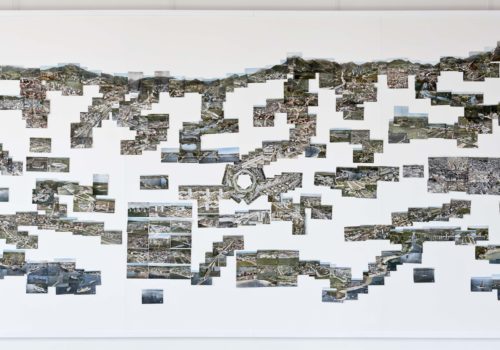For the festival Mois de la Photo du Grand Paris, the Archives Nationales invited Mathieu Pernot to take over the Lapie collection. The collection, acquired by the Archives in 1972, includes, among others, thousands of postcards of arial views taken from airplanes over Metropolitan France during the 1950s and 60s. The result of Mathieu Pernot’s intervention is a double installation, on view through September at the two Archives Nationales sites, in Pierrefitte-sur-Seine and Paris. In Pierrefitte, he created Dorica Castra, a large imaginary map, by associating landscapes postcard through visual analogy, like a giant domino passing through mountains and valleys, bridges and roads, castles and rivers… In Paris, he chose two populated beaches, which he enlarged and arranged along the Hôtel de Soubise’s extravagant courtyard arcade.
In an interview that can be read on the Archives Nationales’ website, Mathieu Pernot defined his work as such: “I’m a photographer, and I take images. They can come from my experience in the real world like and from already existing photographs which I capture to offer a different understanding. Photographing is an act of re-presenting an already existing reality. In cases where I work on found images, you could say that I, once again, offer these re-presentations.” For The Eye of Photography, he revisits the experience with the Lapie collection, his work in general, and his projects.
How did you work?
When the Archives Nationales contacted me, I proposed a puzzle to them, like a child’s game. I didn’t want to reproduce what I had done for the Grand Ensembles or Witnesses (previous series on high-rise housing projects). It interested me to work on the idea of a map, an assemblage, to make a bit of a monumental project. The postcard is a rather emotional object for my generation in any case. I proposed the idea without having tried. I started with the mountains, that was the easiest, and I saw what could be done. An art history student helped me. For two months, three days a week, she went to shops to choose postcards. I gave her nouns: mountain, coastline, river, road, bridge, very identifiable things that I could put in a series. She found eight hundred postcards and I assembled four hundred in a room that the Archives had loaned me so that I could construct my puzzle on the floor. It was quite exhilarating. The result didn’t resemble a map of France. I didn’t want to reconstruct the territory, I wanted to create a new one. Except it’s still a real portrait of France. All the places are documented. It’s an imaginary map, but one that has a historic point of view.
The piece is more like an installation, so artist or photographer?
Sometimes I’m called an artist more than a photographer. I think it’s of no importance. I’ve always said that what interests me is not knowing at what moment a photo becomes or is no longer art, but trying to produce pieces that do away with boundaries. I’m always happy when I see that my work is being used by historians, sociologists, or ethnographers, when I’m invited to a history museum to show my photographs. For example, recently, I participated to a web radio with middle schoolers. I was invited to present my work on migrants to an association for the fight against racism and discrimination, and on gypsies to a finance group. At Pierrefitte, as part of this exhibition, there was a symposium that gathered historians, researchers, and archivists. I speak the same way to all these interlocutors.
Interview by Anne-Claire Meffre
En avion au-dessus de… (In an airplane over…)
Dialogue between Mathieu Pernot and the Lapie collection
Through September 19, 2017
Archives Nationales
60, rue des Francs-Bourgeois
75003 Paris
and
59, rue Guynemer
93383 Pierrefitte-sur-Seine
















